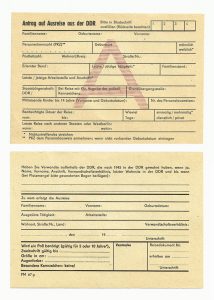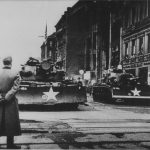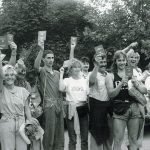
The East German opposition was fed by various sources; among the opposition members were also those who wanted to leave the country and no longer considered the GDR capable of reform. They considered permanent emigration to West Germany as the only alternative to change their living conditions. With the announcement of the opening of the Hungarian border on 2 May 1989, they had to look for alternative ways to leave the country. Finally, with the opening of the Hungarian border, a movement of refugees began to emerge, as the GDR became less and less committed to reform. The electoral fraud in the local elections alone indicated an unwillingness to reform, so that for many contemporaries it was considered advisable not only to wait for the people to leave the country or to venture across Hungary, but also to campaign for improvements in their own living conditions.
Many East Germans hoped to reach the West via Hungary. But the Wall still existed; even though the border security agreements that had existed between the Eastern bloc states began to break down, as the unity of the Eastern bloc states also became obsolete. Thus, they refused to deport the refugees because there was hardly any ideological bond left between Hungary and the GDR. The refugees took the opportunity to flee again if necessary. In this context, the Pan-European Picnic took place, during which the East German refugees used an occassionally opened border to leave Hungary via Austria. The Hungarian leadership was prepared for this situation and opened the border on 10 September 1989 so that the East German refugees could leave for a country of their choice. The situation in Hungary also had an effect on the GDR, and the mass exodus had an effect on the opposition in the GDR.
It was not until the late summer of 1989 that an opposition formed again, which expressed itself freely and publicly addressed the need for reform in the GDR. Finally, the bloodletting of people became apparent in everyday life, and leaving the country via Hungary became a political issue. The New Forum was formed as early as 8/9 September 1989. This platform expressed political criticism freely and reliably for everyone for the first time in several decades. Other opposition groups also engaged in political activity. Democracy Now and Democratic Awakening, for example, were also founded. These organisations formed a civil rights movement, which created novel possibilities for participation at the time.
This soon led to new protest marches through the city centres of Leipzig and Berlin. Thus there were situations that could no longer be stopped by the authorities because there was a constant danger of people leaving the country via Hungary. Even the surveillance of the opposition did not change the fact that the demonstrations spread to other cities. Threats of violence by the state and the party became obsolete because the party shied away from violence in order not to lose its authority.
Nevertheless, it became clear that the new possibility of protest did not mean the end of the demands. In the end, the situation could not be clarified to such an extent that the protests came to an end. Thus, despite the protests, there were still people willing to leave the country who tried to leave via Czechoslovakia. The West German embassy building in Prague was besieged by refugees in order to extort their departure. As early as October 1989, the refugees were able to force their way out, so that West German Foreign Minister Genscher had to declare that their departure would be granted. However, the East German side insisted that the trains bringing the East Germans to the West should pass through East German territory. It turned out that the passage of the trains through the GDR was accompanied by protests. Eventually, clashes broke out in Bad Schandau and Dresden, which the police tried to quell. East Germans wanted to get on the trains to travel with them to the West. At one point, the protesters used a pram to make the trains stop, but this failed as the trains ran through the empty pram. The East Germans arrived happily in West Germany.
The events showed that for the first time since 17 June 1953 there were protests in Dresden, Bad Schandau, Leipzig and Berlin. Orders and chains of command failed so that protests successfully meandered through the inner cities. These events showed how protests were linked to the movement to leave the country and the East German opposition. On 4 November 1989, a good one million people were on the streets in Berlin and Leipzig to demonstrate for social improvements. The pressure from the streets forced the SED to make concessions. On 9 November 1989, the border was opened at Bornholmer Strasse because the demand for freedom of travel created enormous pressure which the DRR regime had to give in to. A misunderstanding in the media thus led to the fall of the Wall, which to this day symbolises the collapse of the GDR regime.
Associated with the fall of the Wall was the right to travel freely to the Western world. This right was made possible by the opening of the border at Bornholmer Strasse. Günther Schabowski’s statement that all citizens could travel to the Western world immediately led to the GDR admitting its loss of power. The fall of the Wall brought the end of the GDR to the fore as the central event, and with it came the imminent reunification of the two German states. Chancellor Kohl drew up a roadmap for reunification in his 10 Points, which was also widely shared by West Germans and West German politics. Thus, the fall of the Wall also led to reunification, as Kohl’s policy had made the unity of Germany the top priority. Thus, the emigration movement and the protests of the East German opposition led to the fall of the Wall.



